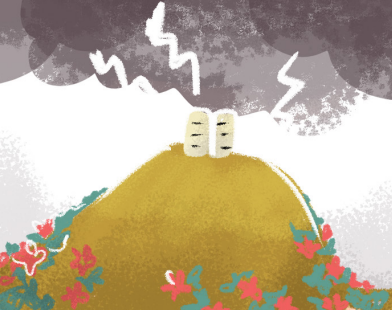
Tell Me More About This! בּוֹאוּ נְדַבֵּר עַל זֶה

The shofar reminds us of receiving the Torah on Har Sinai!
וַיְהִי בַיּוֹם הַשְּׁלִישִׁי בִּהְיֹת הַבֹּקֶר וַיְהִי קֹלֹת וּבְרָקִים וְעָנָן כָּבֵד עַל הָהָר וְקֹל שֹׁפָר חָזָק מְאֹד…
On the third day (the day of receiving the Torah), when it was morning, thunder and lightning and a heavy cloud was on the mountain, and the voice of the shofar was very strong...
The shofar will be used to announce when מָשִׁיחַ (mashiah, the redeemer) comes.
וְהָיָה בַּיּוֹם הַהוּא יִתָּקַע בְּשׁוֹפָר גָּדוֹל וּבָאוּ הָאֹבְדִים בְּאֶרֶץ אַשּׁוּר וְהַנִּדָּחִים בְּאֶרֶץ מִצְרָיִם וְהִשְׁתַּחֲווּ לַיהוה בְּהַר הַקֹּדֶשׁ בִּירוּשָׁלִָם׃
On that day, a great shofar will be blasted; the ones lost in Assyria and the ones cast aside in Egypt will come and bow down to God at the holy mountain in Yerushalayim.

Shofar announces the יוֹבֵל (yovel) year, when slaves go free and everyone who was forced to sell their land gets it back.
וְהַעֲבַרְתָּ שׁוֹפַר תְּרוּעָה בַּחֹדֶשׁ הַשְּׁבִעִי בֶּעָשׂוֹר לַחֹדֶשׁ בְּיוֹם הַכִּפֻּרִים תַּעֲבִירוּ שׁוֹפָר בְּכָל אַרְצְכֶם׃
וְקִדַּשְׁתֶּם אֵת שְׁנַת הַחֲמִשִּׁים שָׁנָה וּקְרָאתֶם דְּרוֹר בָּאָרֶץ לְכָל יֹשְׁבֶיהָ…
You shall sound the shofar on the tenth day of the seventh month. On Yom Kippur you shall sound the shofar throughout your land.
You shall make the 50th year holy. You shall proclaim freedom throughout the land for everyone living there...
The word shofar sounds a lot like the Hebrew word שֶׁפֶר (shefer, beautiful). Because of this, a midrash says that the shofar reminds us to beautify the way we act—a nice way of saying we have to do teshuvah (Midrash Tehillim 81).
Akeidat Yitzhak is the story of when Avraham almost sacrifices his son Yitzhak, but then at the last minute God tells him to sacrifice a ram instead. A midrash suggests God and Avraham had a conversation in that moment:
עֲתִידִין בָּנָיו שֶׁל יִצְחָק לַחֲטוֹא לְפָנַי וַאֲנִי דָן אוֹתָם בְּרֹאשׁ הַשָּׁנָה. אֶלָּא אִם מְבַקְשִׁין שֶׁאֲחַפֵּשׂ לָהֶן זְכוּת וְאֶזְכֹּר לָהֶן עֲקֵדַת יִצְחָק, יִהְיוּ תוֹקְעִין לְפָנַי בְּשׁוֹפָר שֶׁל זֶה.
אָמַר לוֹ: וּמַה הוּא הַשּׁוֹפָר?
אָמַר לוֹ: חֲזוֹר לַאֲחוֹרֶיךָ.
מִיָּד, וַיִּשָּׂא אַבְרָהָם אֶת עֵינָיו וַיַּרְא וְהִנֵּה אַיִל אַחַר נֶאֱחָז בַּסְּבַךְ בְּקַרְנָיו.
God said, “In the future, the children of Yitzhak will sin before Me and I will judge them on Rosh Hashanah. But if they want Me to find them innocent and to remember Akeidat Yitzhak for them, have them blow a shofar of this ram before Me.”
Avraham said to God, “What shofar?!”
God said to him, “Turn around.”
That’s when the Torah says: Avraham lifted his eyes and saw—and there was a ram caught by its horns in the bushes! (Bereishit 22:13)
- Try it out! Each time you listen to the shofar, think about one of these five ways to understand it. What do Har Sinai and Akeidat Yitzhak have to do with Rosh Hashanah? What kind of redemption and freedom are you praying for this year? Can the shofar help you do teshuvah?

Click here to return to the Table of Contents for Rosh Hashanah from Devash
-------------------





